Abstract
This article concerns P. Turin Cat. 1877, a papyrus containing a litany to Osiris and royal ancestors on the recto and a set of administrative texts on the verso. The list of Osiris’ names corresponds to spell 142 of the Book of the Dead, to which the scribe added the names of the main pharaohs, some queens, and some princesses of the 18th Dynasty and the early 19th Dynasty. Most of these royal figures belonged to the family of Ramses II, suggesting that the recto of the papyrus probably dates to the reign of Ramses II, while the verso may date slightly later in the Ramesside Period. The association of names of Osiris with royal names is very rare and the papyrus was probably used in a cultic context, offering an interesting example of a Book of the Dead spell also used in a ritual.
1. Presentation and content of P. Turin Cat. 1877
1.1. Description of the papyrus
The papyrus Turin Cat. 1877 consists of twelve fragments recognized so far (Figs.1-15).1 Further fragments may exist in the Turin collection. Assemblage of joining fragments has reduced the twelve to eight distinct fragments, currently mounted under different glasses. The size of the current fragments in their largest section, as mounted in the frames, is:
Fragment 1: height 17 cm, length 6.8 cm (Figs. 1,2).
P. Turin Cat. 1877 recto, fragments 1, 2 and 3. Scan by the Museo Egizio. https://papyri.museoegizio.it/d/133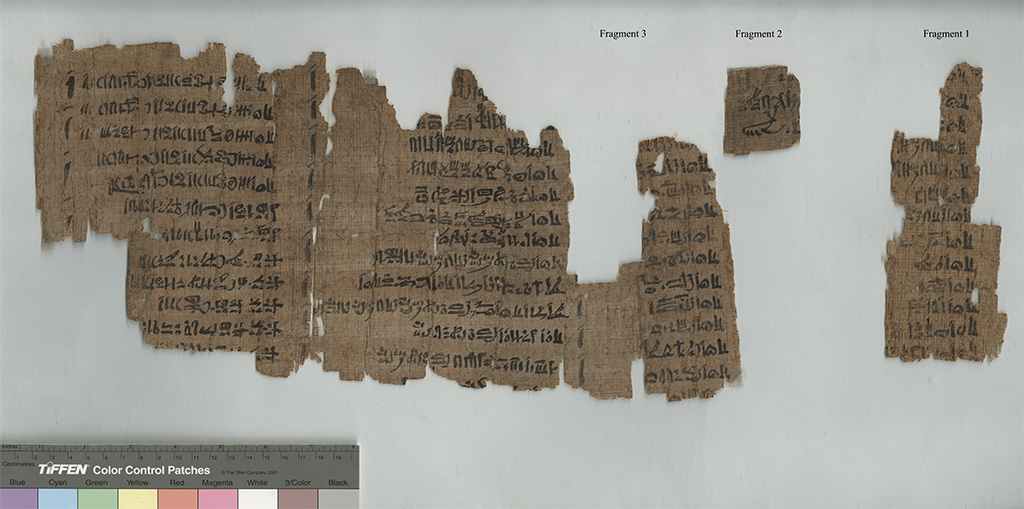
P. Turin Cat. 1877 verso, fragments 1, 2 and 3. Scan by the Museo Egizio. https://papyri.museoegizio.it/d/133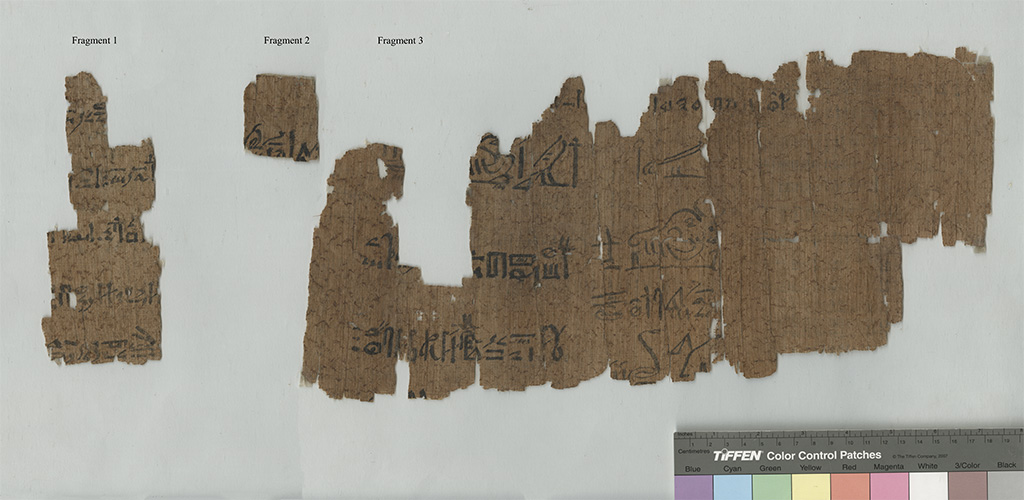
Fragment 4 (CP116/001 + CP116/008): height 14.1 cm, length 2.8 cm (Figs. 3, 4, 5, 6; subfragments joined in Fig. 7).
CP116/001 recto, fragment 4, subfragment 1. Scan by the Museo Egizio.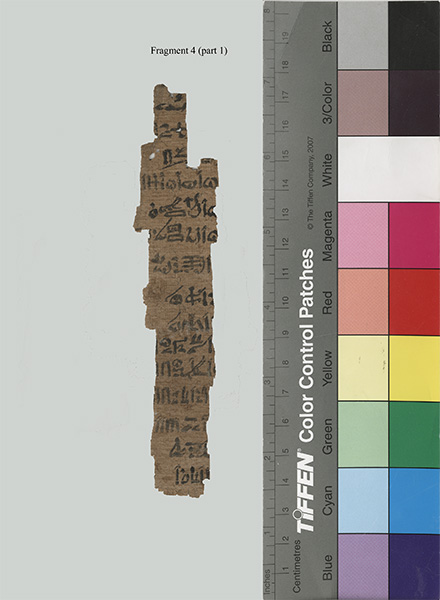
CP116/001 verso, fragment 4, subfragment 1. Scan by the Museo Egizio.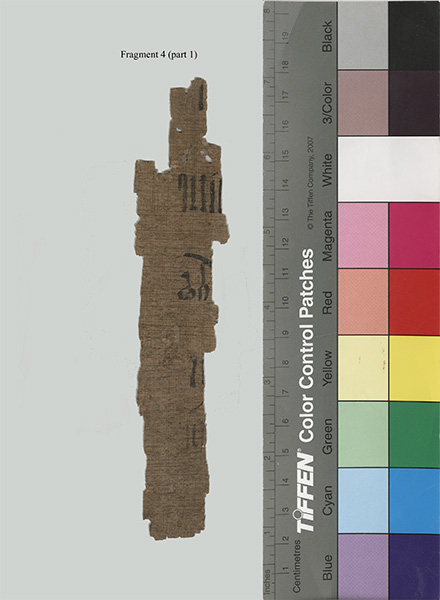
CP116/008 recto, fragment 4, subfragment 2. Scan by the Museo Egizio.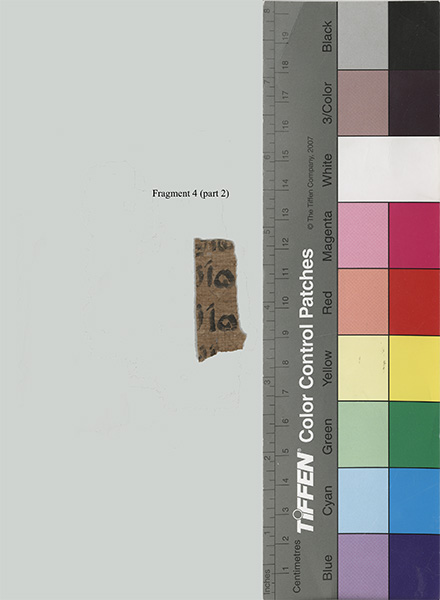
CP116/008 verso, fragment 4, subfragment 2. Scan by the Museo Egizio.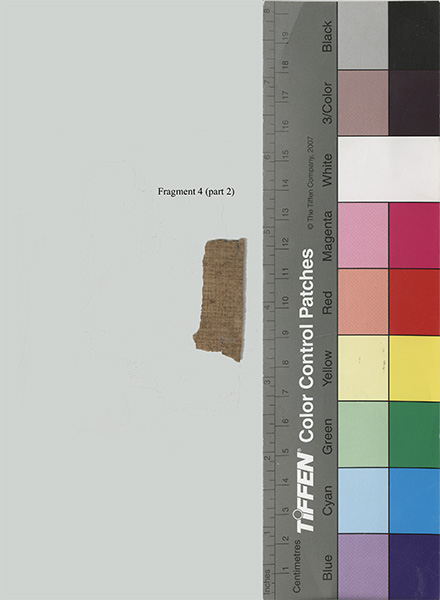
CP116/001 + CP116/008 recto (left) and verso (right), fragment 4, complete. Restitution by Renaud Pietri. Scan by the Museo Egizio.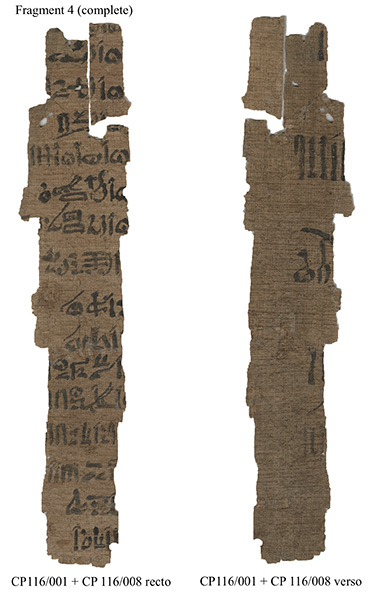
Fragment 5 (CP116/002): height 10.7 cm, length 2.8 cm (Figs. 8,9).
CP116/002 recto, fragment 5. Scan by the Museo Egizio.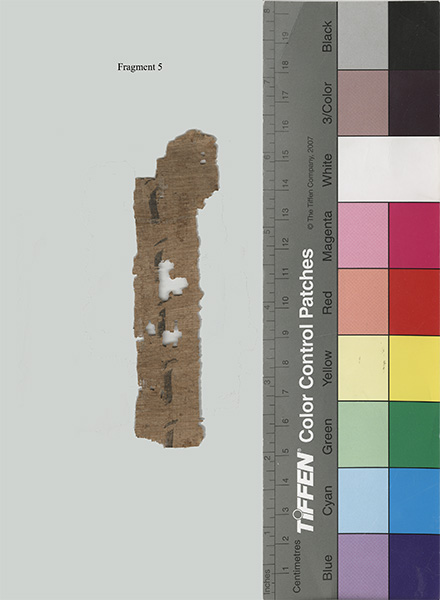
CP116/002 verso, fragment 5. Scan by the Museo Egizio.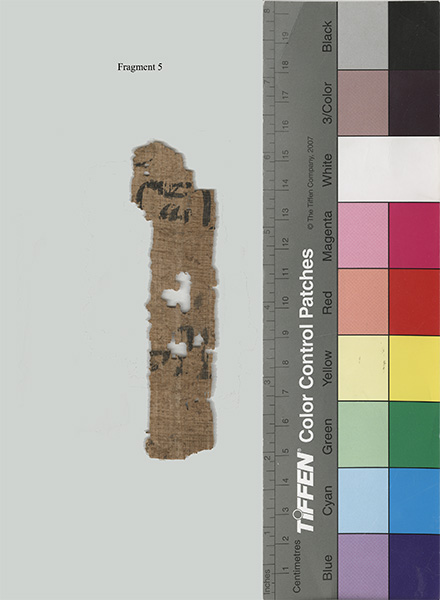
CP116/004 recto, fragment 6. Scan by the Museo Egizio.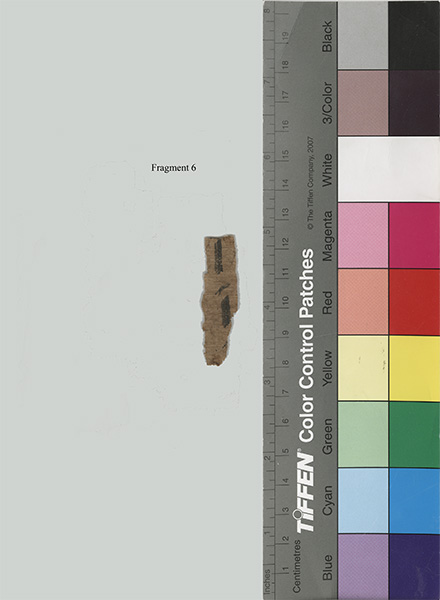
CP116/004 verso, fragment 6. Scan by the Museo Egizio.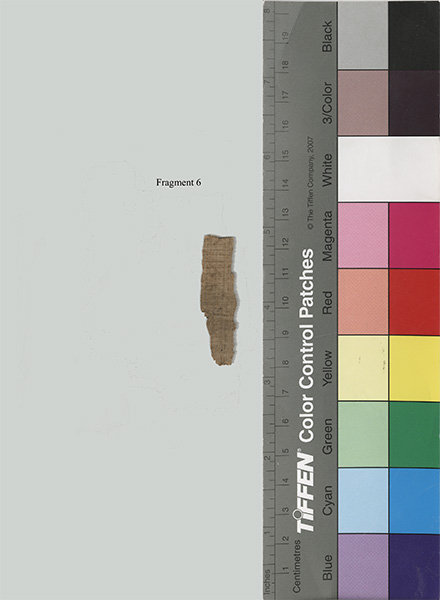
CP111/086 recto, fragment 7. Scan by the Museo Egizio.
CP111/086 verso, fragment 7. Scan by the Museo Egizio.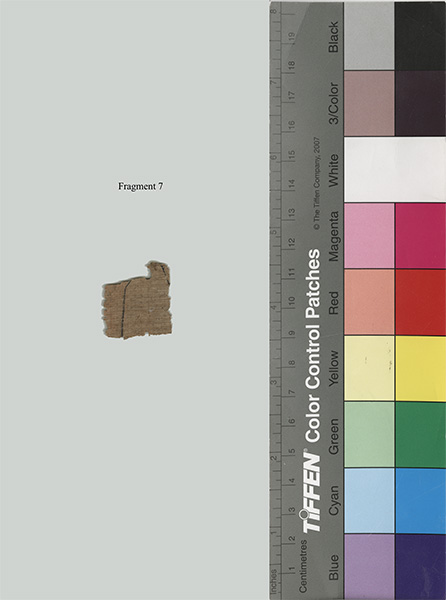
CP147/034 recto, fragment 8. Scan by the Museo Egizio.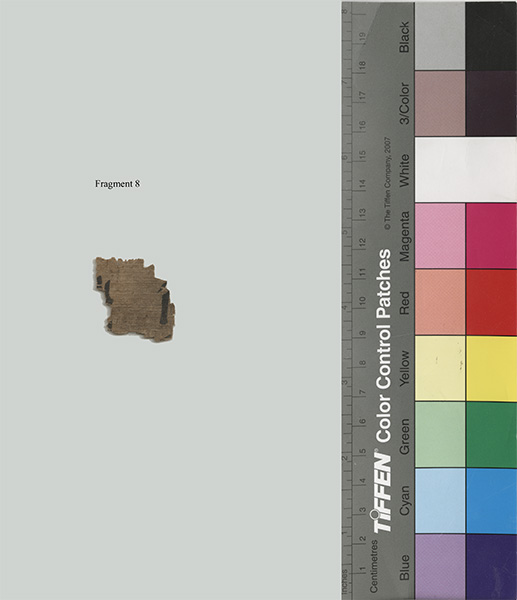
CP147/034 verso, fragment 8. Scan by the Museo Egizio.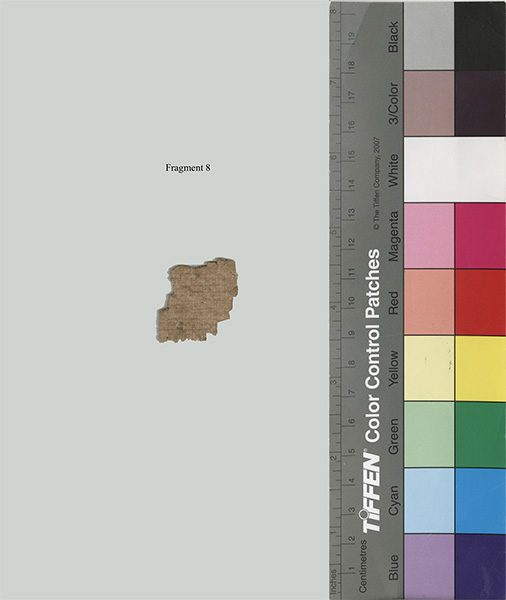
The position of the second fragment is not certain. Based on the content of the recto and the position of the fibers of the papyrus, it could be placed at the end of the second column. As for the verso, the scribal hand may correspond to that of the previous column, but the content of the column – the royal titulary of Ramses VI – suggests placement of the fragment in the middle of the second column. In this case, however, the content of the recto would
Fragment 4 can be placed under column II, the first of fragment 3 (see below), so that the height of the papyrus can be estimated at at least 34.1 cm, probably more if fragment 2 is to be placed in this column also.
Moreover, there would have been enough space at the top of column IV of the recto for another line of text, but this space is empty, so it seems reasonable to assume that the column begins with its first preserved line. The scribe included a date at the same position on the verso of the papyrus, which is appropriate for the beginning of a column. The content of the recto of column IV suggests that 8 lines of text are missing at the end of column III. Taking into account the restitution of column II and the content of columns III and IV, we can suggest that each column contained at least 31 lines and measured approximately between 34,1 cm and 39,2 cm in height (see below).
1.2. Provenance and studies of the papyrus
The papyrus belongs to the Drovetti collection, acquired by king Carlo Felice of Savoy in 1824. There is no indication about the text’s provenance, but it may come from Deir el-Medina like the majority of papyri from the Drovetti collection in the Museo Egizio.3 It was presented for the first time by Jean-François Champollion in 1826, in one of his letters to the Duc de Blacas d’Aulps.4 It was subsequently studied by Willem Pleyte and Francesco Rossi, who produced a facsimile and a commentary.5 A brief description is found some years later in the catalogue of Ariodante Fabretti, Francesco Rossi, and Rodolfo V. Lanzone.6 Some scholars have examined the recto. Kenneth A. Kitchen provided a
1.3. Content and date of the papyrus
The recto contains an extract of a litany to Osiris (corresponding to Spell 142 of the Book of the Dead) followed by the names of kings, queens, and princesses, mostly belonging to the New Kingdom. Based on the presence of women of the family of Ramses II (e.g., his mother, his wife Nefertary, and at least four daughters), we can suppose that the recto was written during his reign. However, the handwriting would also be compatible with a later date during the Ramesside Period (see palaeography below). In this case, the original was perhaps written during Ramses’ reign and later copied. The verso contains three or four extracts from various texts, each written by a different scribe. Among these texts is an extract from the royal titulary of Ramses VI and what seems to be an administrative text that includes a date.11 This part was then probably composed after the recto, but no later than the Ramesside Period.
1.4. Palaeography of the recto of the papyrus
It seems that scribes from Deir el-Medina did not have a specific, recognizable writing style, although we can identify the hands of some famous scribes.12 The writing on the papyrus resembles literary cursive, as it is less cursive than administrative texts and lacks many of the ligatures often observed in them.13 Unfortunately, a palaeography of manuscripts from Deir el-Medina or from the Ramesside Period is still lacking,14 so I must limit myself to a comparison with signs in the second volume of Georg Möller’s palaeography15 or the magical papyri from Turin studied by Alessandro Roccati, with a palaeography by the present author16 (Table 1).17
Palaeography of P. Turin Cat. 1877 recto, choice of signs.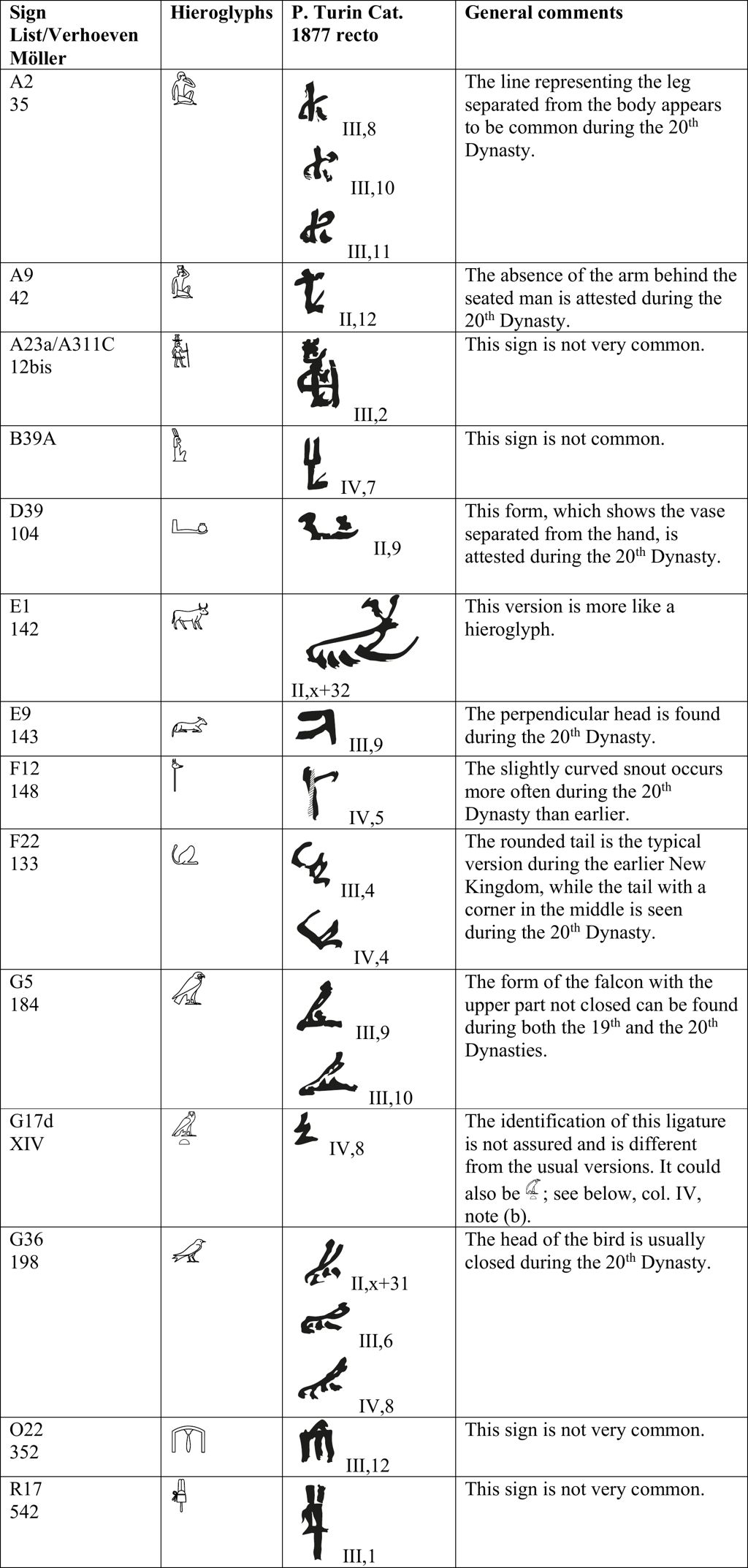
This short presentation of signs seems to indicate that many are more common in the 20th than in the 19th Dynasty.18 Since, as already mentioned above, complete palaeographical data are still lacking for the Ramesside period, it appears that palaeography only is an inconclusive criterion for accurate dating of the recto of the papyrus. All it tells us is that it dates from the Ramesside Period, most likely the 20th Dynasty; however, because of the content of the text (see above), the 19th Dynasty cannot be ruled out. As for the verso, the presence of the royal titulary of Ramses VI allows us to date it during his reign.
2. Translation and commentary of P. Turin Cat. 1877 recto (Figs. 16–17)
P. Turin Cat. 1877 recto, restitution with fragments 1, 2, 3 and 4. Scan by the Museo Egizio.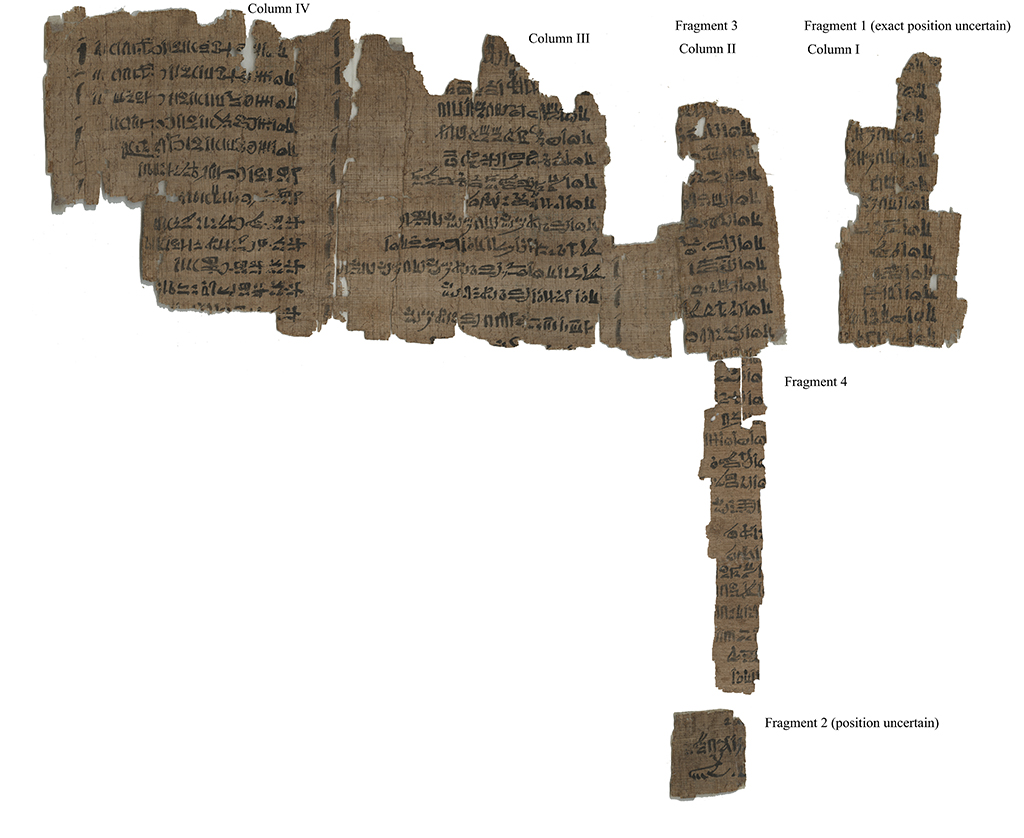
P. Turin Cat. 1877 recto, hieroglyphic transcription, fragments 1, 2, 3 and 4.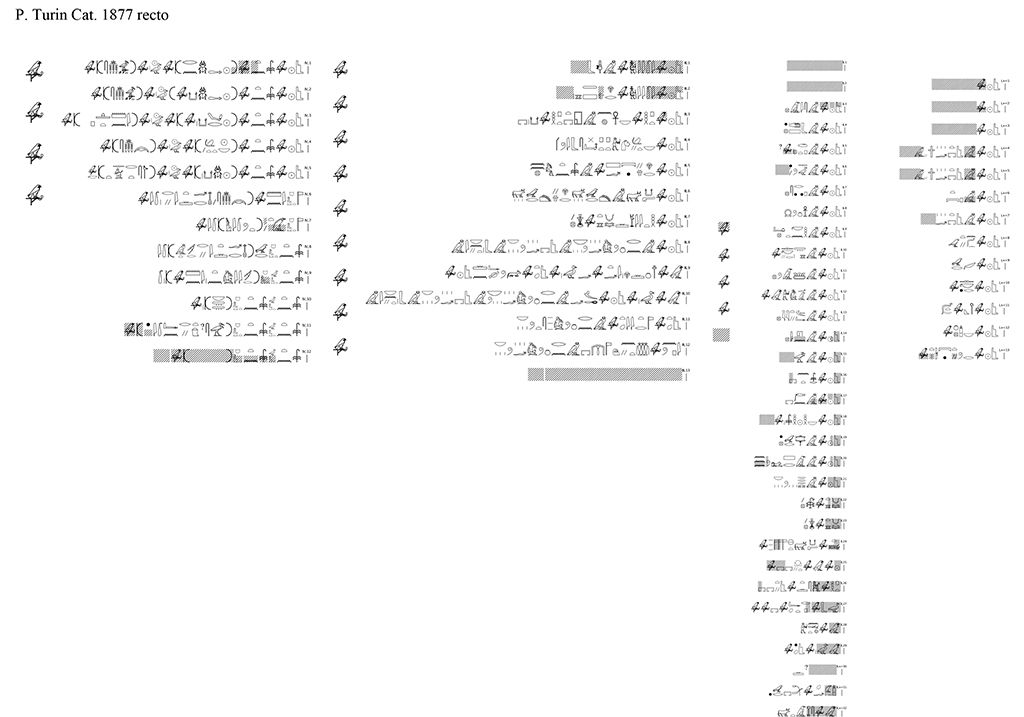
The recto of P. Turin Cat. 1877 currently consists of four columns that contain a variant of the so-called Spell 142 of the Book of the Dead. Fragment 4 (CP116/001 + CP116/008), based on its content and the few traces left at its beginning, is certainly the continuation of the first column of fragment 3, that is, column II. In this case, this column would consist of at least 29 lines and be 34.1 cm high. It is unclear, instead, where exactly the last fragment at the end of column II (i.e., fragment 2) should be positioned with respect to the previous fragments. The content suggests a position at the end of column II, but this is uncertain and the join between the two fragments is difficult to determine. If we add this fragment to column II, then this column would contain at least 32 lines and be at least 39.2 cm in height.
Spell 142 is generally found combined with Spell 141 during the New Kingdom and the Third Intermediate Period, although they form two separate spells from the Late Period onwards.19
Book of the Dead papyri used as parallels for the translation (corresponding to BD 142)
2.1. Fragment 1, column I
On the first preserved fragment, column I includes 13 lines of text. The two subfragments it is composed of were joined sometime in the last century, as Pleyte and Rossi’s 1869–1876 publication depicts the column on two separate fragments.29 The position of the fragment relative to the one with columns II–IV is uncertain; it could be placed slightly lower (as in Fig. 16), but the lacunae are two large for a confident decision to be made in this regard. In any case, based on all known versions of BD 142 from the New Kingdom, to which this papyrus dates, column I certainly comes before column II.

I,x+1
I,x+1 Osiris [ ] (a).
I,x+2
I,x+2 Osiris [ ] (a).
I,x+3
I,x+3 Osiris [ ] (a).
I,x+4
I,x+4 Osiris [in] (b) his places that are in [Upper Egypt].
I,x+5
I,x+5 Osiris [in] (b) his places that are in [Lower Egypt] (c).
I,x+6
I,x+6 Osiris [in] the sky.
I,x+7
I,x+7 Osiris in his places [that are in Ro-setau].
I,x+8
I,x+8 Osiris Nedjes (d).
I,x+9
I,x+9 Osiris Itefa-wer.
I,x+10
I,x+10 Osiris Sokar.
I,x+11
I,x+11Osiris ruler of eternity.
I,x+12
I,x+12Osiris lord of Heliopolis.
I,x+13
I,x+13Osiris <in> Ruty-iset (e).
Notes on the translation
(a) Columns I and II are very similar to the version of BD 142 in the Osireion at Abydos, so that we can wonder if the missing names of Osiris at the beginning of column I are not
(b) Traces of the preposition m are still visible in the facsimile of Pleyte and Rossi.30
(c) I have made the restitution after the version of the Osireion at Abydos (register II, no 33 for “Osiris in his places in Upper Egypt” and register II, no 32 for “Osiris in his places of Lower Egypt”), but I suggest to place Upper Egypt before Lower Egypt as it is the preferred order in this papyrus (see for example II,16-II,17 or II,22-II,23). P. Nu (col. 96) only contains the name of Osiris with “Lower Egypt.”31
(d) Or
(e) Ruty-iset is probably a toponym and seems to correspond to the current city of Abusir, as Didier Devauchelle observes.32 Another translation, adopted by LGG II, 551, prefers “Osiris, der um die Mannschaft (außen) herum ist”. Furthermore, “Osiris in Heliopolis” and “Osiris <in> Ruty-iset” are not included either in the list of the Osireion or in P. Nu, but they are in P. Berlin P 3002 (3rd register, no 11, 4th register, no 1).33
2.2. Fragments 3 and 4, column II
Column II spans at least two fragments: the first column of fragment 3 (column II of the currently reconstructed text), which corresponds to the upper part of the papyrus and contains 14 lines of text, and fragment 4, which corresponds to the lower part with 15 lines. To these two fragments, a further fragment with 3 lines can be added based on the fibers of the papyrus and the similar content. If we compare the upper part of this column with column IV, which probably includes the upper part of the papyrus, it appears that 2 lines at the beginning of the column are missing, so that we can estimate the column to have contained between 29 lines (without fragment 2) and 32 lines (with fragment 2).
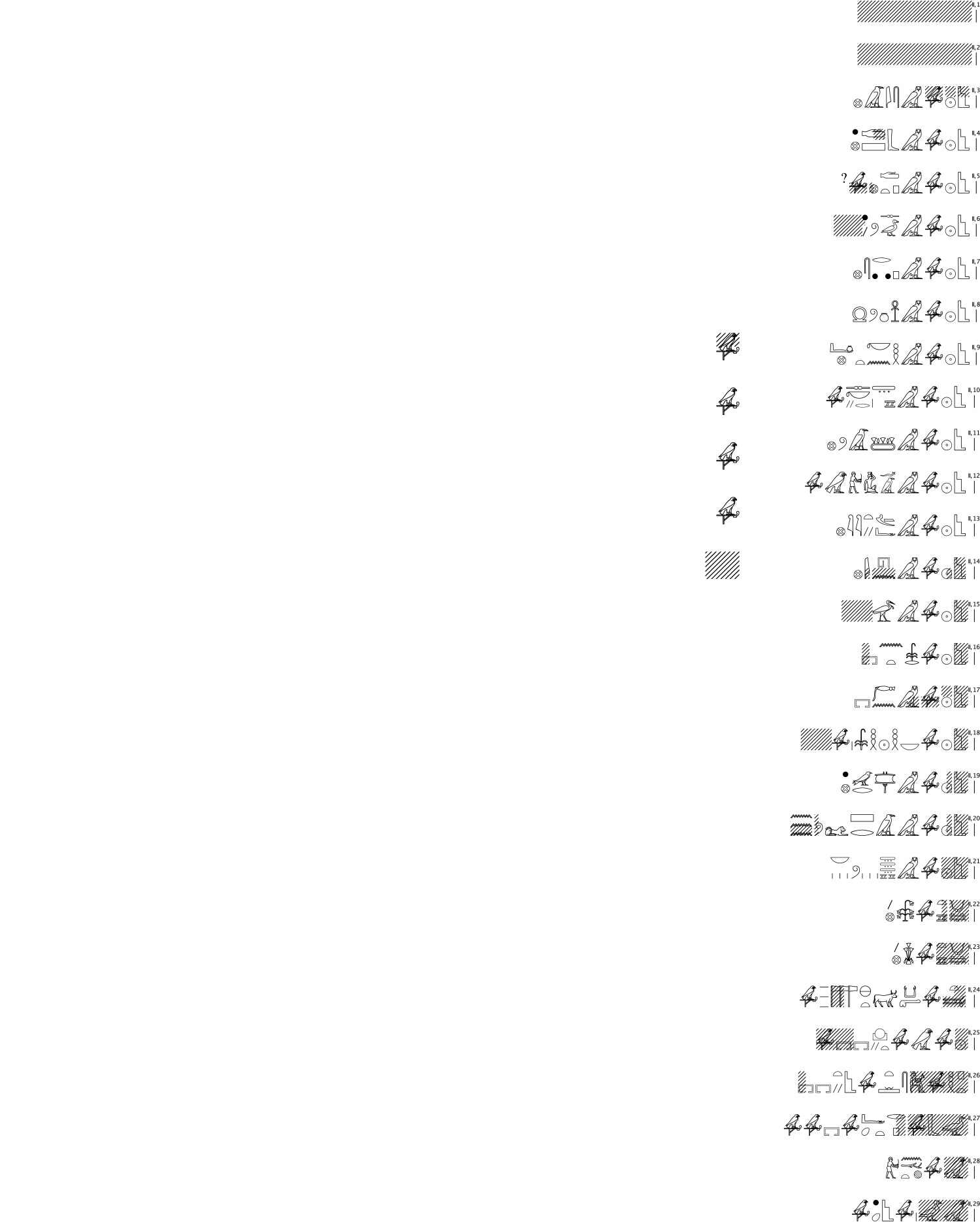
Fragment 2

II,1
II,1 [Osiris ].
II,2
II,2 [Osiris ].
II,3
II,3 Osiris in Sia.
II,4
II,4 Osiris in Bedesh.
II,5
II,5 Osiris in Dep (Buto).
II,6
II,6 Osiris in [upper] Sais.
II,7
II,7 Osiris in Peretes (?) (a).
II,8
II,8 Osiris in Shenu.
II,9
II,9 Osiris in Henket.
II,10
II,10 Osiris in the Land of Sokar.
II,11
II,11 Osiris in Shau.
II,12
II,12 Osiris as He-who-carries-Horus.
II,13
II,13 Osiris in Maaty.
II,14
II,14 Osiris in Heni (b).
II,15
II,15 Osiris in Ba-[of-the-father] (c).
II,16
II,16 Osiris in the South Chapel.
II,17
II,17 Osiris in the North Chapel (d).
II,18
II,18 Osiris, lord of eternity, king [of the gods].
II,19
II,19 Osiris in the nome of Abydos (e).
II,20
II,20 Osiris in Isheru (e).
II,21
II,21 Osiris in every land (e).
II,22
II,22 [Wepwaw]et of Upper Egypt (f).
II,23
II,23 [Wepwawet] of Lower Egypt.
II,24
II,24 [Atum], bull of the [great] Ennead (g).
II,25
II,25 [Ra]-Horakhty.
II,26
II,26 [Ptah], excellent [djed-pillar], throne [of Ra].
II,27
II,27 [Geb], prince of the gods.
II,28
II,28 [Horus] the victorious (h).
II,29
II,29 [Horus]-son-of Isis.
II,x+30
II,x+30 [ ] ? (i)
II,x+31
II,x+31 [Iunmut]ef, he who purifies Per-wer (i).
II,x+32
II,x+32 [Hor-sekh]a (i).
Notes on the translation
(a) This version of the sequence is unknown, as most others have Neperet in this position (compare P. Nu, col. 105, no 2; P. Kha, third line of names, no 27, while P. Neferrenpet, l. 16, has
(b) Fragments 3 and 4 can be placed here. The reading
(c) The restitution is based on the version of the Osireion, register III, no 21, and P. Greenfield, 35f,2 which share a similar sequence for this passage as in
(d) The reading of the sign  is uncertain. It could be the group
is uncertain. It could be the group  for
for  (Möller II, no 165B / Sign list F26). In this case, it could refer to the (royal) Residence or simply to the interior of some building. This epithet is attested for deities in lists in temples, as in the Litany of Sokar in Medinet Habu as
(Möller II, no 165B / Sign list F26). In this case, it could refer to the (royal) Residence or simply to the interior of some building. This epithet is attested for deities in lists in temples, as in the Litany of Sokar in Medinet Habu as
(e) “Osiris in the nome of Abydos”, “Osiris in Isheru” and “Osiris in every land” are well-known in late versions of BD 142 (see P. Greenfield, 35f,10, 35f,12, 35f,13; P. Iahtesnakht, 68c,19, 68e,8 and 68e,9 and P. Iuefankh 2,4 and 3,4 for “Osiris in Isheru” and “Osiris in every land”). For the New Kingdom, only the Osireion seems to contain these names (register III, no 24, 26, 27). Thus, the Osireion and P. Greenfield have the same order as P. Turin Cat. 1877, but with a further name after “Osiris in the nome of Abydos”, that is “Osiris in Deni” (P. Greenfield, 35f,11 and Osireion, register III, no 25).
(f) From this point (II,22) to the end of the preserved column (II,29), and maybe also of fragment 2, are the names of other deities than Osiris that are preserved in versions later than the New Kingdom. The restitutions are given here following P. Greenfield (36a,5-36a,18), which has a similar structure. The versions are somewhat different in the Late and Ptolemaic periods (compare P. lah-tes-nakht, 68f,2-68f,14). As for “[Wepwaw]et of Upper Egypt” and “[Wepwawet] of Lower Egypt”, later versions have “Wepwawet of Upper Egypt, mighty one of the Two Lands” and “Wepwawet of Lower Egypt, mighty one of the sky” (P. Greenfield, 36a,5-36a,6; P. Iahtesnakht, 68f,3-68f,4). In P. Turin Cat. 1877, it seems that nothing is written after the words “Upper Egypt” and “Lower Egypt”.
(g) The restitution of “[Atum], bull of the Ennead” follows P. Greenfield, 36a,7 and P. Iahtesnakht, 68f,2, but both versions have “Atum, bull of the body of the great Ennead”, the word “body” (
(h) Other later versions register “Min the king, Horus the victorious” (P. Greenfield, 36a,14; P. Iahtesnakht, 68f,11) instead of “[Horus] the victorious”. In P. Turin Cat. 1877, there is not room enough for the name of Min and his function.
(i) The following three lines belong to a fragment whose position is uncertain, making it impossible to say how many lines are missing between the two fragments. The few traces in the first line are not enough to identify a name, but the last two lines could correspond to BD 142, the version usually found in the Late and Ptolemaic Periods (P. Iahtesnakht 68f,12 and 68f,14, but without the
2.3. Fragment 3, column III
Column III contains at least 13 lines, with the first line of the column probably preserved, based on a comparison with column IV.
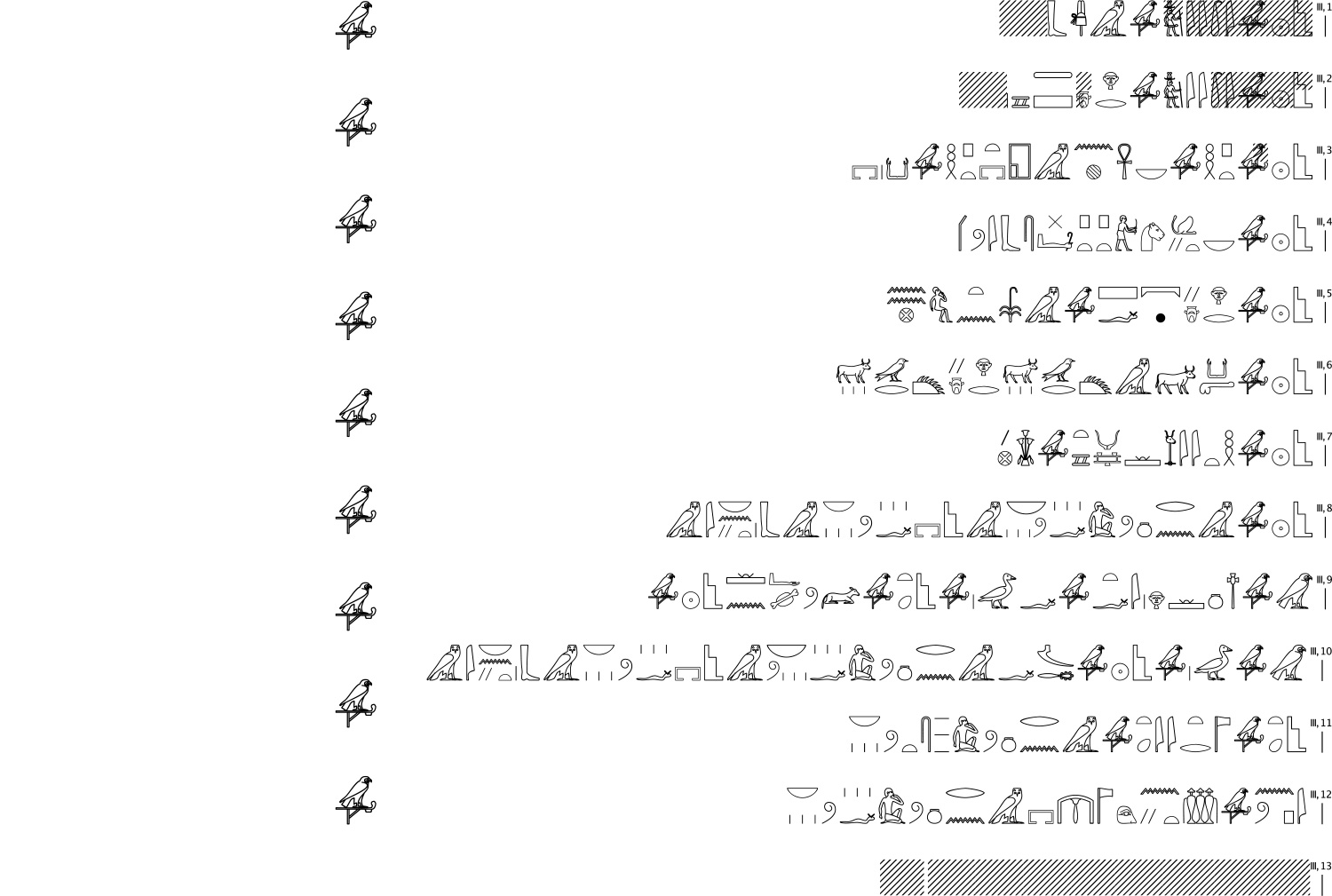
III,1
III,1 [Osiris sovereign] in Abydo[s] (a).
III,2
III,2 [Osiris sove]reign in the middle of To-she (a).
III,3
III,3 Osiris Ptah lord of Life in Memphis.
III,4
III,4 Osiris lord of strength who tramples the enemies.
III,5
III,5 Osiris Herishef in Heracleopolis (b).
III,6
III,6 Osiris, bull in Kem-wer, in the middle of Kem-wer (Athribis) (c).
III,7
III,7 Osiris the breather, Wepwawet of Upper Egypt (d).
III,8
III,8 Osiris in all his names, in all his places, in each location in which (he) is.
III,9
III,9 Horus who protects his father, son of Isis, heir of Osiris.
III,10
III,10 Horus son of Osiris, he who justifies, in all his names, in all the places, in each location in which (he) is.
III,11
III,11 Isis divine in all her names.
III,12
III,12 Anubis foremost of the pavilion in all his names.
III,13
III,13 [ ] (e).
Notes on the translation
(a) Restitutions are made according to P. Greenfield (35f,22–23), which has a very similar litany listing the same forms of Osiris (P. Greenfield, 35f,22–36a,5).
(b) The association of Osiris with Herishef in Spell 141/142 seems to be very rare. P. Greenfield gives “Osiris, lord of Heracleopolis” (94c,15). Only P. Hohenzollern-Sigmaringen II (col. 1,11)37 and the version in the Osireion of Abydos (register III, no 33) explicitly mention “Osiris-Herishef, lord of Heracleopolis”.
(c) Vernus includes numerous attestations of this form of Osiris, both in the Litanies of Osiris in the ritual context and in Spell 142.38
(d) Wepwawet should be written on another line (compare with P. Greenfield, 36a,5).
(e) Some traces are visible, but they are insufficient to suggest a restitution.
2.4. Fragment 3, column IV
Column IV contains 12 lines with a space above the first line that allows us to infer that this fragment preserves the original beginning of the column.

IV,1
IV,1 Osiris, king (Aakheperrenra)|, son of Ra (Thutmosis)| (Thutmosis II).
IV,2
IV,2 Osiris, king (Aakheperkara)|, son of Ra (Thutmosis)| (Thutmosis I).
IV,3
IV,3 Osiris, king, (Djeserkara)|, son of Ra (Amenhotep)| (Amenhotep I).
IV,4
IV,4 Osiris (Nebpehtyra)|, son of Ra (Ahmosis)|.
IV,5
IV,5 Osiris (Kheperkara)|, son of Ra (Sesostris)| (Sesostris I).
IV,6
IV,6 Divine wife of Amun (Ahmes-Nefertary)| (wife of Ahmosis).
IV,7
IV,7 Divine wife, (royal) mother (Tuti)| (a) (mother of Ramses II).
IV,8
IV,8 Great king’s wife (Nefertary)| beloved of Mut (b) (wife of Ramses II).
IV,9
IV,9 King’s daughter, (king’s) wife (Merytamun [ )| ] (daughter of Ramses II).
IV,10
IV,10 King’s daughter, king’s wife (Nebettauy)| (daughter of Ramses II).
IV,11
IV,11 King’s daughter, king’s wife (Batanat)| (daughter of Ramses II).
IV,12
IV,12 King’s daughter, king’s wife [( )|] (c).
Notes on the translation
(a) The writing
(b) The ligature  at the end of the cartouche clearly refers to the name of the goddess Mut, as it often appears in the cartouche of Queen Nefertary – though it is normally written at the beginning of the cartouche, or at least before
at the end of the cartouche clearly refers to the name of the goddess Mut, as it often appears in the cartouche of Queen Nefertary – though it is normally written at the beginning of the cartouche, or at least before  (KRI II, 922), although it could also be a ligature of the vulture-glyph with a “t” (
(KRI II, 922), although it could also be a ligature of the vulture-glyph with a “t” ( ).
).
(c) The traces in the last line are insufficient to identify the name of Ramses II’s daughter here. Kitchen (KRITANC II, 622) surmised that it might be Henutmira.
2.5. Fragments 5-8
Fragment 5 (CP116/002) (Figs. 8,9) and fragment 6 (CP116/004) (Figs. 10,11) only contain parts of columns with the sign  on the recto, while some signs are written on the verso of fragment 5 and nothing is written on the verso of fragment 6. Fragment 7 (CP111/086) (Figs. 12,13) only shows traces of signs that could may be
on the recto, while some signs are written on the verso of fragment 5 and nothing is written on the verso of fragment 6. Fragment 7 (CP111/086) (Figs. 12,13) only shows traces of signs that could may be  in the first line and the name of Osiris followed by a scarab
in the first line and the name of Osiris followed by a scarab  in the second. On the verso, this fragment carries part of a vertical line. As for fragment 8 (CP147/034) (Figs. 14,15), it shows the sign
in the second. On the verso, this fragment carries part of a vertical line. As for fragment 8 (CP147/034) (Figs. 14,15), it shows the sign  and few traces of the beginning of the name of Osiris
and few traces of the beginning of the name of Osiris  , and nothing on the verso. They are certainly part of P. Turin Cat. 1877, but their exact position is hard to determine.
, and nothing on the verso. They are certainly part of P. Turin Cat. 1877, but their exact position is hard to determine.
2.6. General comment on P. Turin Cat. 1877 recto
The recto of P. Turin Cat. 1877 lists names of Osiris that correspond to BD 141/142 – specifically the second part of Spell 142, dedicated to Osiris – in association with the names of royal ancestors and members of the royal family.
1. Names of Osiris and other deities (columns I–III)
2. Royal names (column IV)
3. The fragmentary texts on P. Turin Cat. 1877 verso (Figs. 18–19)
The verso of P. Turin Cat. 1877 contains three or four different texts that have no relationship with the recto. The papyrus was probably reused after the scribe had copied the main text on the recto. As the focus of this article is on the litany on the recto, I will only provide a description of, and very short comment on, this part of the papyrus, as it could be useful for further, more detailed research.
P. Turin Cat. 1877 verso, restitution with fragments 1, 2, 3 and 4. Scan by the Museo Egizio.
P. Turin Cat. 1877 verso, hieroglyphic transcription, fragments 1, 2, 3 and 4.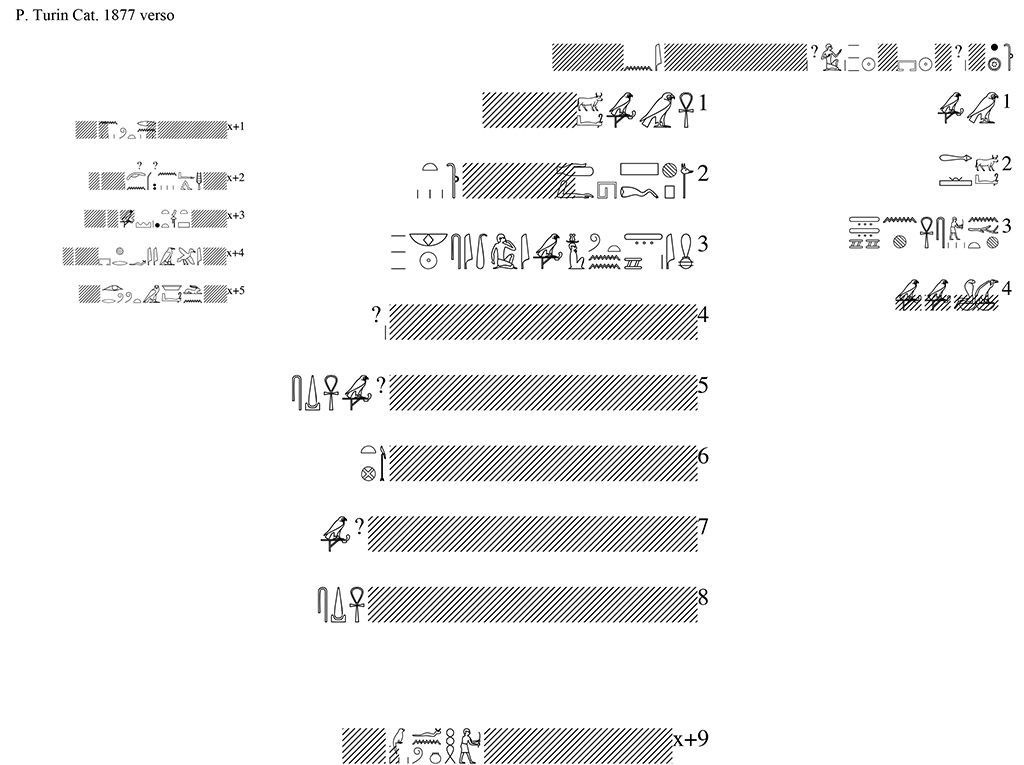
3.1. Text 1
The first text on the verso contains only a single line with traces of a date.

Year 1 (?) [month ?] of the peret season [ ], day 3 ? [ ] ?
3.2. Text 2
Text 2 consists of two columns containing elements of a royal titulary, probably referring to Ramses VI. The two columns seem to belong to the same text, though this is not certain since each seems to have been written by a different scribe. We can compare, for example, the way that Horus is written at the beginning of each column and the type of ink used, which is darker in the left column. Fragment 4 is placed at the end of this column because of the content of the recto. Finally, the position of the fragment at the end of the second column (fragment 2) is not certain. The signs in these two columns are higher than in the other texts on the papyrus.
Text 2, column 1

1
1 Horus,
2
2 strong bull, great of
3
3 victories, who makes the Two Lands live
4
4 the Two Ladies
[ ]
Text 2, column 2
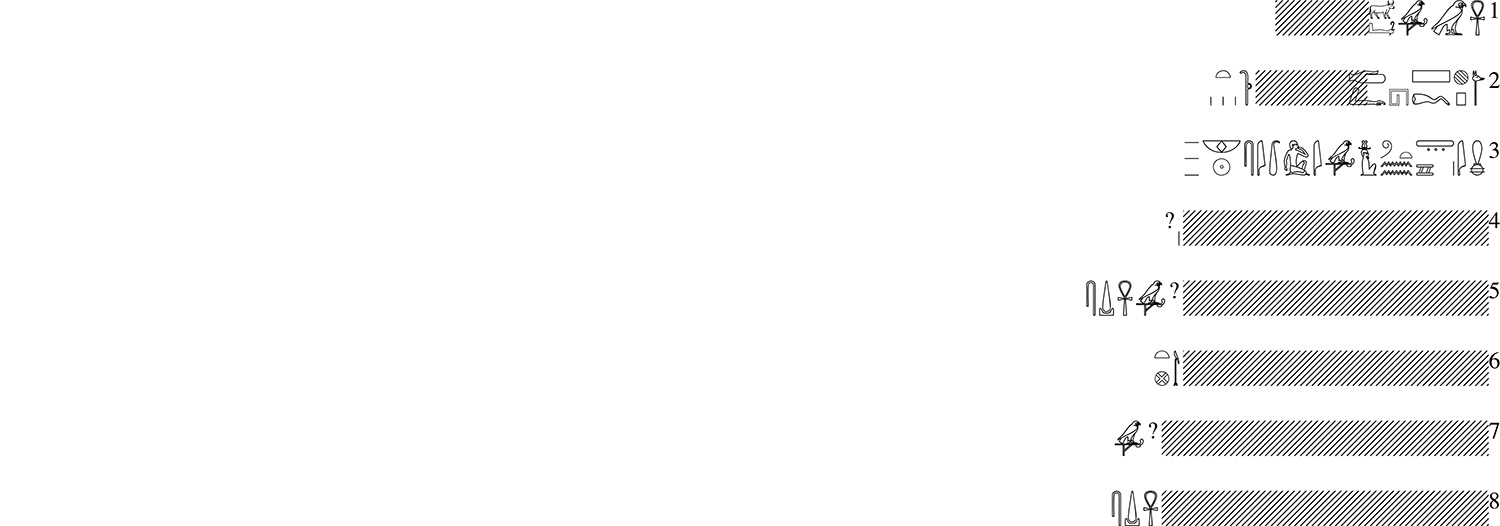
Fragment 2

The position of fragment 2 would make sense in the lacuna in line 2 because of the meaning. In this case, the complete line would be: 
But there does not seem to be enough room and it would have no sense for the meaning of the recto, which is why I prefer to place fragment 2 somewhere near the end of the column, even though this position remains uncertain.
1
1 May Horus the strong bull live, [great of victories],
2
2 powerful of arm, who prevails over [the hundreds of thousands], <powerful of> years,
3
3 like Tatenen, sovereign of the Sed(-festival).
4
4 [ ]
5
5 [ ] may he live, be prosper and be healthy.
6
6 [ ] Thebes.
7
7 [ ]
8
8 [ ] may he live, be prosper and be healthy.
x+9
x+9 [ ] the hundreds of thousands [ ].
The fragment x+9 would be better placed in the lacuna of line 2, so that the translation would be: “who prevails over the hundreds of thousands,” the Nebty-name of Ramses VI.40 Thus, the whole column gives the royal titulary of Ramses VI (Horus name, Nebty-name, and Golden Horus name). However, although such a reconstruction would theoretically work for the verso, it would not produce a coherent text for the recto; but this fragment could be part of the Nebty-name of Ramses VI repeated in the lower part of the column.
3.3. Text 3
This fragmentary text written in five lines is difficult to identify and translate because only a few traces remain legible. According to Pleyte and Rossi, who did not realize that the two fragments belonged together, the text described the construction of a tomb (because of the presence of the word

4. Some remarks on litanies of Osiris and royal names in the cultic context
The text written on the recto of P. Turin Cat. 1877 is a name list enumerating several forms of Osiris, other deities, and members of the royal family. The Osirian list in this text corresponds to the one found in Spell 141/142 of the Book of the Dead.43 As remarked above, the spell was usually a single one during the New Kingdom and the Third Intermediate Period, and was then separated into two distinct spells with their own titles (141 and 142) during the Saite Period. An exception for the New Kingdom is P. Berlin P. 3002 (19th Dynasty), which only contains Spell 142.44 Thus, in this period Spell 142 could also occur alone in the Book of the Dead. Spell 141 lists the names of various divine entities, while 142 mostly contains names of Osiris, with some names of Horus, Isis, Anubis, and Wepwawet. The spell(s) is/are very well attested in funerary contexts from the New Kingdom to the Ptolemaic Period, mostly on papyri and in tombs.45
Attestations of Spell 141/142 in Deir el-Medina are not frequent. Among them are P. Kha of the 18th Dynasty and P. Neferrenpet of the 19th. As said, these attestations resemble only columns I and II of P. Turin Cat. 1877. So far, it is not possible to distinguish a specific tradition of the names of Osiris in Deir el-Medina. Furthermore, the version in P. Turin
Indeed, versions with the names of Osiris (i.e., similar to Spell 142) often appear in the context of temples. In addition to the mentioned version in the Osireion at Abydos,46 Jean-Claude Goyon indicated the Litany of Sokar in Medinet Habu.47 In his publication of P. Hohenzollern-Sigmaringen II of the fourth century BCE, Joachim Friedrich Quack also argues that the text was originally used in a temple context.48 This is also the case for the ritual performed during the Festival of Khoiak, attested in P. Louvre N 3176 S of the Roman Period.49
Two papyri published by Raymond O. Faulkner likely also stem from a temple context: the Book of Hours (P BM EA 10569, Late Period)50 and the litany in Giessen University Library Papyrus no. 115 (end of the Ptolemaic Period or early Roman Period).51 Furthermore, the Book of Hours is the only papyrus that associates Osiris’ names with kings and queens, but the latter are only referred to by the general expression “The Kings of Upper Egypt and the Kings of Lower Egypt”.52 Moreover, the demotic liturgies of P. Berlin P. 6750 and P. Berlin P. 8765 of the Roman Period also contain a version of Spell 142.53
Like Spell 142 and other texts like it, the litany of P. Turin was thus probably a wdnw (“offerings” or “litany of offerings”) used in a temple context. What is particular about this papyrus is the presence of pharaohs’, queens’, and princesses’ names in addition to those of Osiris. Name-lists of royal ancestors such as the Ramesseum list, the Abydos list, or those found in ritual papyri are common enough.54 The names of royal ancestors can vary from one document to the next, or even within the same papyrus – as in the Ritual of Amenhotep I.55 Usually Mentuhotep II was the main pharaoh for the Middle Kingdom, but in some cases Sesostris I is also be mentioned, as indeed in P. Turin Cat. 1877.56
These lists rarely mention female members of the royal family. There are of course exceptions, such as Queen Ahmes-Nefertary, wife of Ahmose,57 or women of the royal family of the 18th Dynasty, who appear in stelae, tombs, papyri, and other objects from Deir el-Medina.58 The queens and daughters of the family of Ramses II occasionally appear in temple lists, as do the sons of Ramses II, but they are not attested together in a liturgy following a litany of Osiris, as seen in the Turin papyrus.59 Therefore, it seems that priests introduced the names of the royal family on this papyrus in order to associate them with the offering ritual usually devoted to Osiris. Another interesting point is that the names of kings are prefixed by “Osiris”, while those of women are prefixed only by the title they bore during their lives. This may indicate that they were still alive when the papyrus was copied (with the exception, of course, of Ahmes-Nefertary).
The ritual on this papyrus was certainly used in a temple where royal ancestors and living members of the royal family were invoked so that they could benefit from the cult and the offerings. Kitchen wondered if this text may stem from the archives of Ramses II in Abydos.60 This could be possible because of the links between the version in the Osireion and in P. Turin Cat. 1877. Yet, the papyrus was probably found in Deir el-Medina, where other lists are known,61 and was certainly used in a Theban temple, but a common model with the Osireion‘s version is possible. At some point, probably during the Ramesside Period, it was then reused to record administrative texts and a royal titulary.
Bibliography
Barguet, Paul, Le Papyrus N. 3176 (S) du Musée du Louvre (BdE 37), Le Caire 1962.
von Beckerath, Jürgen, Handbuch der ägyptischen Königsnamen (MÄS 49), Mainz 1999.
Černý, Jaroslav, Papyrus hiératiques de Deir el-Médineh I [Nos I-XVII] (DFIFAO 8), Le Caire 1978.
Černý, Jaroslav, Papyrus hiératiques de Deir-el-Médineh Tome II [Nos XVIII-XXXIV] (DFIFAO 22), Le Caire 1986.
Champollion, Jean-François, Lettres à M. le duc de Blacas d’Aulps relatives au Musée Royal Égyptien de Turin. Seconde lettre – Suite des monuments historiques, Paris 1826, pp. 43–57. Online : https://digi.ub.uni-heidelberg.de/diglit/champollion1826bd2/ .
Coulon, Laurent, “Objets, textes et contextes : réflexions sur la reconstitution des rites osiriennes à Karnak”, in: Joachim Friedrich Quack and Daniela C. Luft (eds.), Schrift und Material: praktische Verwendung religiöser Text- und Bildträger als Artefakte im alten Ägypten (ORA 41), Tübingen 2021, pp. 167–83.
Coulon, Laurent, “À propos des listes et séries divines en Égypte ancienne : la mise en série des formes d’Osiris à Karnak”, in: Gabriella Pironti, Corinne Bonnet, Romain Loriol (eds.), Dieux en série? Approche comparée des listes divines dans les religions antiques, Archiv für Religionsgeschichte, forthcoming.
Devauchelle, Didier, “Osiris, Apis, Sarapis et les autres. Remarques sur les Osiris Memphites au Ier millénaire av. J.-C.”, in : Laurent Coulon (ed.), Le culte d’Osiris au Ier millénaire av. J.- C. Découvertes et travaux récents. Actes de la table ronde internationale tenue à Lyon, Maison de l’Orient et de la Méditerranée (Université Lumière-Lyon 2) les 8 et 9 juillet 2005 (BdE 153), Le Caire 2010, pp. 49–62.
Enany, Khaled el-, “La vénération post mortem de Sésostris Ier”, Memnonia 14 (2003), pp. 129–37.
El Shazly, Yasmin, Royal Ancestor Worship in Deir el-Medina During the New Kingdom, Wallasey 2015
El Shazly, Yasmin, “Female Royal Ancestors in Deir el-Medina” in: Giuseppina Lenzo, Christophe Nihan, and Matthieu Pellet (eds.), Les cultes aux rois et aux héros à l’époque hellénistique: continuités et changements (Orientalische Religionen in der Antike 44), Tübingen, 2022, pp. 59–87.
Fabretti, Ariodante, Francesco Rossi, and Rodolfo Vittorio Lanzone, Regio Museo di Torino. Antichità Egizie (Catalogo generale dei Musei di Antichità e degli oggetti d’arte raccolti nelle gallerie e biblioteche del regno. Serie Prima – Piemonte), I, Torino 1882.
Faulkner, Raymond O., An Ancient Egyptian Book of Hours (Pap. Brit. Mus. 10569), Oxford 1958.
Faulkner, Raymond O., “Giessen University Library Papyrus No. 115”, JEA 44 (1958), pp. 66–74.
Fischer-Elfert, Hans-Werner, “Hieratic Palaeography in Literary and Documentary Texts from Deir el-Medina” in: Vanessa Davies, and Dimitri Laboury (eds.), The Oxford Handbook of Egyptian Epigraphy and Palaeography, New York 2020, pp. 647–62.
Gaballa, Gaballa Ali and Kenneth A. Kitchen., “The festival of Sokar”, Orientalia 38 (1969), pp. 1–76.
KRI II = Kitchen, Kenneth Anderson, Ramesside Inscriptions: Historical and Biographical, vol. II. Ramesses II. Royal Inscriptions, Oxford 1979.
KRITANC = Kitchen, Kenneth Anderson, Ramesside Inscriptions: Historical and Biographical, vol. II. Ramesses II, Translated and Annotated. Royal Inscriptions, Oxford 1996.
Lapp, Günther, The Papyrus of Nu (BM EA 10477). (Catalogue of the Books of the Dead in the British Museum 1), London 1997.
Lenzo, Giuseppina, “The Two Funerary Papyri of Queen Nedjmet (P. BM EA 10490 and P. BM EA 10541 + Louvre E. 6258)”, BMSAES 15 (2010), pp. 63–83, https://webarchive.nationalarchives.gov.uk/ukgwa/20190801114225/https://www.britishmuseum.org/research/publications/online_journals/bmsaes/issue_15/lenzo.aspx.
Lenzo, Giuseppina, “Paleografia”, in: Alessandro Roccati, Magica taurinensia: Il grande papiro magico di Torino e i suoi duplicati (AnOr 56), Turin 2011, pp. 195–255.
Lenzo, Giuseppina, “The Names of Osiris in the Litany of the So-Called Spell 141/142 of the Book of the Dead in Ancient Egypt” in: Corinne Bonnet, Thomas Galoppin, Martine Joly, Sylvain Lebreton, Fabio Porzia, Jörg Rüpke (eds.), Naming and Mapping the Gods in the Ancient Mediterranenan: Spaces, Mobilities, Imaginaries, Berlin, Boston, De Gruyter, forthcoming A.
Lenzo, Giuseppina, The Greenfield Papyrus. Funerary Papyrus of a Priestess at Karnak Temple (c. 950 BCE) (British Museum Publications on Egypt and Sudan 15), Leuven, forthcoming B.
Lepsius, Richard, Das Todtenbuch der Ägypter nach dem hieroglyphischen Papyrus in Turin, Leipzig 1842.
Lüscher, Barbara, Totenbuch-Papyrus Neuchâtel Eg. 429 und Princeton Pharaonic Roll 2: zur Totenbuch-Tradition von Deir el-Medina (BAÄ 1), Basel 2007.
Medinet Habu IV: The Epigraphic Survey, Medinet Habu, volume 4: Festival Scenes of Ramses III (OIP 51), Chicago 1940.
Milde, Henk, The Vignettes in the Book of the Dead of Neferrenpet (EgUit 7), Leiden 1991.
Möller, Georg, Hieratische Paläographie II. Die ägyptische Buchschrift in ihrer Entwicklung von der fünften Dynastie bis zur römischen Kaiserzeit. Von der Zeit Thutmosis’ III. bis zum Ende der einundzwanzigsten Dynastie, Leipzig 1927.
Möller, Georg, Hieratische Paläographie III. Die ägyptische Buchschrift in ihrer Entwicklung von der fünften Dynastie bis zur römischen Kaiserzeit. Von der zweiundzwanzigsten Dynastie bis zum dritten Jahrhundert nach Chr., Leipzig 1936.
Mosher Jr, Malcolm, The Book of the Dead, Saite Through Ptolemaic Periods: A Study of Traditions Evident in Versions of Texts and Vignettes (BD Spells 129–143) (SPBDStudies 8), Middletown (DE) 2020.
Munro, Irmtraut, Das Totenbuch des Nacht-Amun aus der Ramessidenzeit (pBerlin P. 3002) (Handschriften des Altägyptischen Totenbuches 4), Wiesbaden 1997.
Murray, Margaret A., The Osireion at Abydos (British School of Archaeology in Egypt and Egyptian Research Account 9), London 1904.
Pleyte, Willem e Francesco Rossi, Papyrus de Turin, 2 vols., Leiden 1869–1876.
Redford, Donald B., Pharaonic King-Lists, Annals and Day-Books: A Contribution to the Study of the Egyptian Sense of History, (SSEA Publications 4), Mississauga 1986.
Tacke, Nikolaus, Das Opferritual des ägyptischen Neuen Reiches. (OLA 222), Leuven 2013.
Verhoeven, Ursula, Das saitische Totenbuch der Iahtesnacht: P. Colon. Aeg. 10207, Bonn 1993.
Verhoeven, Ursula, Untersuchungen zur späthieratischen Buchschrift (OLA 99), Leuven 2001.
Vernus, Pascal, Athribis, Textes et documents relatifs à la géographie, aux cultes et à l’histoire d’une ville du Delta égyptien à l’époque pharaonique (BdE 74), Le Caire 1978.
Widmer, Ghislaine, Résurrection d’Osiris – naissance d’Horus : les papyrus Berlin P. 6750 et Berlin P. 8765, témoignages de la persistance de la tradition sacerdotale dans le Fayoum à l’époque romaine (Ägyptische und Orientalische Papyri und Handschriften des Ägyptischen Museums und Papyrussammlung Berlin 3), Berlin and Boston 2015.
Quack, Joachim Friedrich, “Ein neuer funerärer Text der Spätzeit (pHohenzollern-Sigmaringen II)”, ZÄS 127 (2000), pp. 74–87.
Notes
- I am very grateful to Susanne Töpfer for her help and her welcome at the <i>Museo Egizio</i>, to Stéphane Polis for information about the papyrus, and to Alessandro Roccati for sharing his notes about the papyrus with me. I also would like to thank Laurent Coulon for discussions on this topic and the anonymous peer reviewers for their suggestions. This article is part of a project led by L. Coulon and G. Lenzo on the litanies of Osiris in the framework of the Ifao-program “Transmission des textes funéraires et pratiques rituelles en Égypte ancienne au Ier millénaire av. n.è.: continuités et changements de la Troisième Période intermédiaire à la Basse Époque” (directed by F. Albert and G. Lenzo, 2022–2026). Finally, I am also grateful to Dylan Johnson who corrected the English text and to Federico Poole for editing the article and for his suggestions.↑
- Renaud Pietri very kindly informed me of his discovery and I am extremely grateful to him.↑
- See <a href="https://papyri.museoegizio.it/o/200935">https://papyri.museoegizio.it/o/200935</a>.↑
- Champollion, <i>Lettres à M. le duc de Blacas d’Aulps</i>, 1826, pp. 43–57.↑
- Pleyte, Rossi, <i>Papyrus de Turin</i>, 1869–1876, pp. 22–25, pls. XI–XV.↑
- Fabretti, Rossi, Lanzone, <i>Antichità Egizie</i>, 1882, pp. 239–40.↑
- K<i>RI</i> II, 921, 10–922, 6.↑
- Vernus, <i>Athribis</i>, 1978, p. 290.↑
- Redford, <i>Pharaonic King-Lists</i>, 1986, p. 39.↑
- <a href="https://papyri.museoegizio.it/o/200935">https://papyri.museoegizio.it/o/200935</a>. ↑
- According to the Turin papyrus database, the verso has three texts: a royal titulary, an extract of a literary text, and an administrative text, see <a href="https://papyri.museoegizio.it/Object/Writing/detail.aspx?!iid=715e6f9448e64a878c9b7 532e4e78a91">https://papyri.museoegizio.it/Object/Writing/detail.aspx?!iid=715e6f9448e64a878c9b7 532e4e78a91</a>. ↑
- See Fischer-Elfert, in: Davies and Laboury (eds.), <i>The Oxford Handbook of Egyptian Epigraphy and Palaeography</i>, 2020, pp. 654–57.↑
- On three different styles of hieratic (administrative, chancery script and literary cursive), see Fischer-Elfert, in: Davies and Laboury (eds.), <i>The Oxford Handbook of Egyptian Epigraphy and Palaeography</i>, 2020, pp. 654–57. For examples of various scripts on papyri from Deir el-Medina, see Černý, <i>Papyrus hiératiques de Deir el-Médineh</i>, 1978, 1986.↑
- See also Fischer-Elfert, in: Davies and Laboury (eds.), <i>The Oxford Handbook of Egyptian Epigraphy and Palaeography</i>, 2020, p. 648.↑
- Möller, <i>Hieratische Paläographie</i> II, 1927.↑
- Lenzo, in: Roccati, <i>Magica Taurinensia</i>, 2011, pp. 195–255.↑
- Sign list based on Verhoeven <i>Untersuchungen</i>, 2001.↑
- Sign 12bis in Möller, <i>Hieratische Paläographie</i> III, 1936.↑
- The <i>Totenbuch-Projekt</i> database registers about 125 attestations for all periods, but without distinguishing between 141 and 142 (see <a href="http://totenbuch.awk.nrw.de/">http://totenbuch.awk.nrw.de/</a>).↑
- See Lapp, <i>The Papyrus of Nu</i>, 1997.↑
- Photos at <a href="https://collezionepapiri.museoegizio.it/en-GB/document/439/?inventoryNumber=8438 ">https://collezionepapiri.museoegizio.it/en-GB/document/439/?inventoryNumber=8438</a>. ↑
- See Milde, <i>The Vignettes</i>, 1991, pp. 156–59, pl. 29–30.↑
- A fragment of Spell 141-142 also survives in P. Neuchâtel Eg. 429, from Deir el-Medina; see Lüscher, <i>Totenbuch-Papyrus Neuchâtel Eg. 429</i>, 2007, pp. 4, 6, pl. 3↑
- See Murray, <i>The Osireion at Abydos</i>, 1904, pl. IX.↑
- See Lenzo, <i>BMSAES</i> 15 (2010); Lenzo, in Bonnet et al. (eds.), <i>Naming and Mapping the Gods</i>, forthcoming.↑
- See Lenzo, <i>The Greenfield Papyrus</i>, forthcoming.↑
- See Verhoeven, <i>Das saitische Totenbuch der Iahtesnacht</i>, 1993.↑
- Lepsius, <i>Das Todtenbuch</i>, 1842.↑
- Pleyte, Rossi, <i>Papyrus de Turin</i>, 1869–1876, pl. XIII, fragment IV for the upper part and fragment III for the lower part.↑
- Pleyte, Rossi, <i>Papyrus de Turin</i>, 1869–1876, pl. XIII, fragment III.↑
- P. BM EA 10477, see Lapp, <i>The Papyrus of Nu</i>, 1997, pl. 44.↑
- See Devauchelle, in Coulon (ed.), <i>Le culte d’Osiris</i>, 2010, p. 50, n. 6.↑
- Munro, Das Totenbuch des Nacht-Amun, 1997, pl. 16 (col. 455 and 445).↑
- <i>Medinet Habu</i> IV, pl. 221, col. 4..↑
- K<i>RI</i> II, 625, 69, translated as “in Khenu” (or: “in the Residence”) in K<i>RITANC</i> II, 414.↑
- Mosher, The Book of the Dead, 2020, p. 476.↑
- Quack, <i>ZÄS</i> 127 (2000), pp. 78–79, remark i.↑
- Vernus, <i>Athribis</i>, 1978, pp. 290–94.↑
- <i>Medinet Habu</i> IV, pl. 213. On the content of the list on P. Turin Cat. 1877, see Redford, <i>Pharaonic King-Lists</i>, 1986, p. 39. ↑
- Compare von Beckerath, <i>Handbuch</i>, 1999, p. 95.↑
- Pleyte, Rossi, <i>Papyrus de Turin</i>, 1869–1876, p. 25; see the facsimile in two separate fragments, pl. XV, fragments III and IV.↑
- <a href="https://papyri.museoegizio.it/o/200935">https://papyri.museoegizio.it/o/200935</a>. ↑
- On this spell, see Lenzo, in Bonnet et al. (eds.), <i>Naming and Mapping the Gods</i>, forthcoming A.↑
- Published by Munro, <i>Das Totenbuch des Nacht-Amun</i>, 1997, pl. 16 (lines 436-455).↑
- For the many papyri with Spell 141/142, consult the database of the <i>Totenbuch-Projekt</i>: <a href="http://totenbuch.awk.nrw.de//">http://totenbuch.awk.nrw.de//</a>. A presentation of this spell in the context of this article would be difficult, but a complete study is being prepared by the author.↑
- Murray, <i>The Osireion</i>, 1904, pl. IX.↑
- <i>Medinet Habu</i> IV, pls. 221–22. For the names of Osiris in the cultic context of the Karnak temples, see Coulon, in: Pironti, Bonnet and Loriol, (eds), <i>Dieux en série?</i>, forthcoming.↑
- Quack, <i>ZÄS</i> 127 (2000), see especially pp. 83–86.↑
- Published by Barguet, <i>Le Papyrus N. 3176</i>, 1962; see more recent observations by Coulon, in Quack, Luft (eds.), <i>Schrift und Material</i>, 2021, pp. 176–79.↑
- Faulkner, <i>Book of Hours</i>, 1958.↑
- Faulkner, <i>JEA</i> 44 (1958), pp. 66–74.↑
- P. BM EA 10569, 6,7, see also Redford, <i>Pharaonic King-Lists</i>, 1986, p. 64.↑
- Widmer, <i>Résurrection d'Osiris</i>, 2015, particularly pp. 67–71, 99–111, 194–244. A list of demotic sources can be found in Quack, <i>ZÄS</i> 127 (2000), p. 77, n. 18.↑
- See the presentation of various king-lists in Redford, <i>Pharaonic King-Lists</i>, 1986, pp. 1–64.↑
- Tackes, <i>Das Opferritual</i>, p. 183.↑
- On the mention of Sesostris I in lists, see El-Enany, <i>Memnonia</i> 14 (2003).↑
- See Tackes, <i>Das Opferritual</i>, 2013, scenes 48.8g and 54.24b, vol. I, 201, 263; vol. II, 182–83, 221–25↑
- Redford, <i>Pharaonic King-Lists</i>, 1986, pp. 42–62, for documents stemming from private people. On royal ancestors in Deir el-Medina, see El Shazly, <i>Royal Ancestor Worship</i>, 2015. On female royal ancestors, see El Shazly in: Lenzo, Nihan, and Pellet (eds.), 2022.↑
- See the various documents registered in K<i>RI</i> II, 916–22.↑
- K<i>RITANC</i> II, p. 622, who follows an idea first put forward by Helck, <i>LÄ</i> IV, 1982, 735.↑
- See, for example, an ostracon from the 19<sup>th</sup> Dynasty published by Sauneron, <i>CdE</i> 26 (1951) and other lists in El Shazly, <i>Royal Ancestor Worship</i>, 2015.↑










